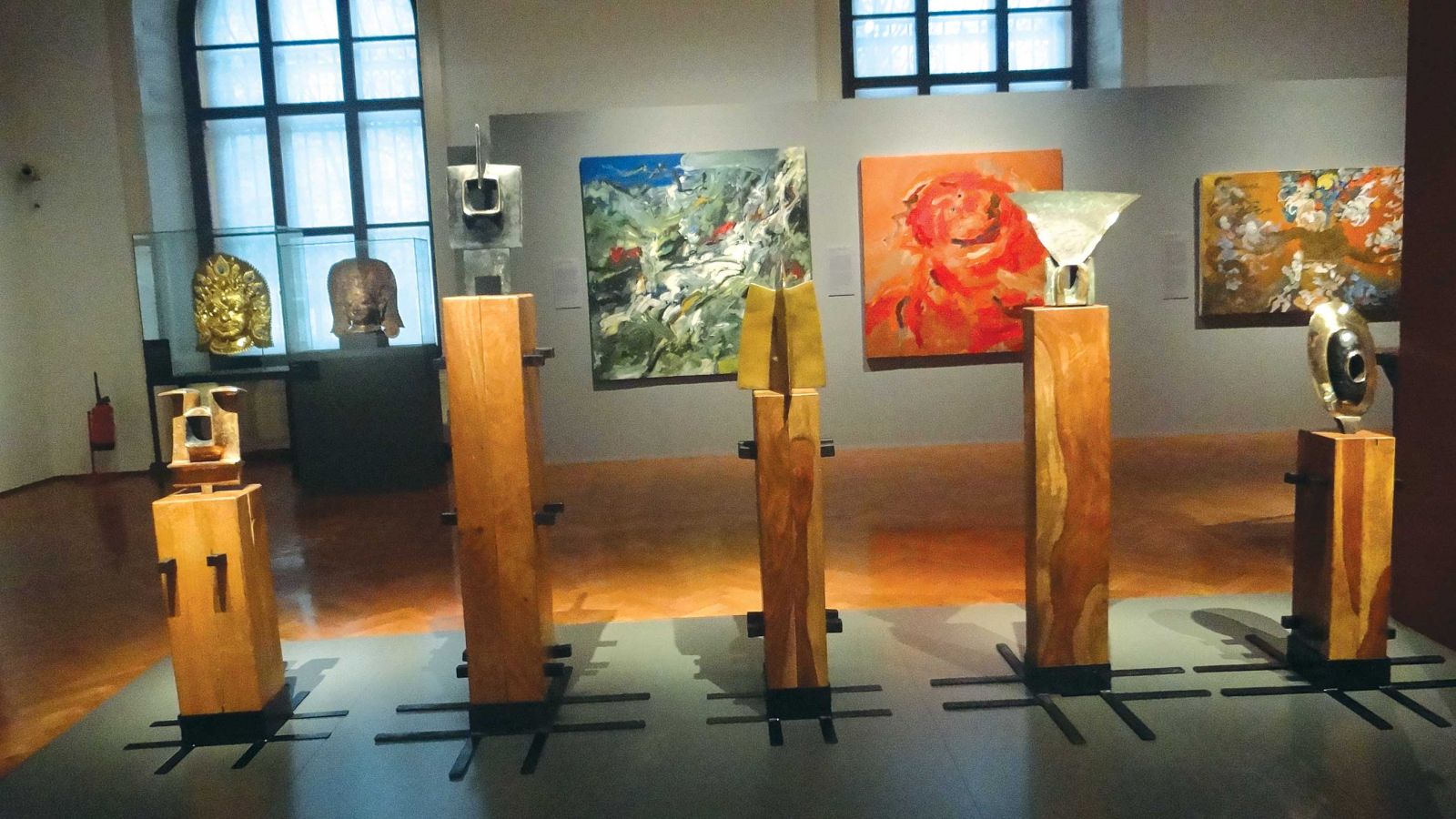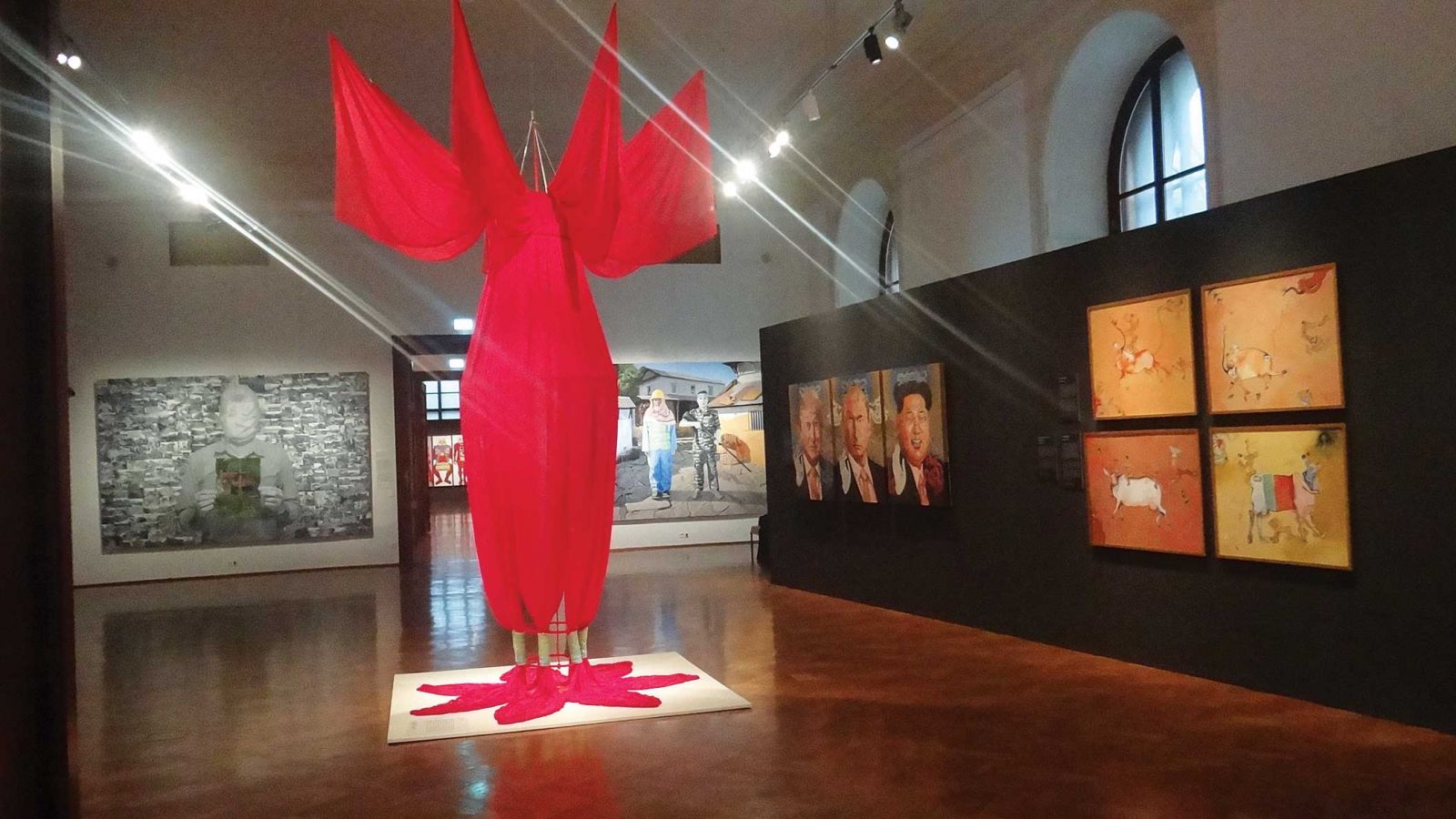
It may come as a surprise to many to know or see the largest exhibition of Nepalese contemporary art, showcasing artwork from the 1950s till today, being exhibited in the ground floor galleries of the Weltmuseum or World Museum in Vienna. This is the largest and first exhibition of its kind being exhibited outside of Nepal. The exhibition features more than a hundred artworks by 37 artists and almost 10 collectors. A separate part of this exhibition featuring Maithili Art created by 14 artists from the Janakpur Women’s Development Centre is located at the mezzanine floor of the museum building. The Weltmuseum is one of the world’s foremost ethnographic museums, with a collection of almost 250,000 ethnographic objects from all over the world and nine curatorial departments.
The history of this historic exhibition took many twists and turns; the initial idea, to have a traveling exhibition, was initiated by the Guimet Musée in Paris. It was to travel from Paris to Vienna to Singapore, and then back to Nepal. The emergent intent was to have an exhibition of Nepalese art objects from the various museums of Nepal. The major twist was the change in the main contents of the exhibition, from traditional art objects dating back from the 6-18th century to contemporary art featuring artworks after the 1950s. The minds behind this change were Dr. Dina Bandgel, Executive Board Member of Nepal Art Council and a renowned scholar and professor of Himalayan Arts, and Dr Christian Schicklgruber, curator of the South Asia Department and Director of the Welt Museum. The planning of this exhibition was paused by the sudden demise of Dr. Dina, in July 2017, but resumed very soon as a dedication to her.
In August 2017, Dr. Schicklgruber contacted Nepal Art Council (NAC)to ask them to be the local partner and organizer of this exhibition, and ever since, the planning moved ahead with great speed and zest. Mr. Sagar SJB Rana, Vice President of Nepal Art Council, was appointed as the project coordinator, and I stepped in as the co-curator. Dr. Schicklgruber sent me a list of approximately 80 artists with an intent to exhibit the works of about 17 of them. This number seemed unreasonable to me, too low to represent contemporary Nepalese art in an international forum, and so we discussed the possibility of increasing the number.
Our search for the selection started by visiting artists at their studios, as well as collectors. We visited about five to seven artists every day for almost 40 days non-stop, because time was short and Dr. Schicklgruber had to attend to his duties back in Vienna. Visiting each artist, viewing their best pieces, taking photographs, and discussing the possibility and potential of this exhibition over a cup of tea and snacks was very enjoyable, yet very exhausting. By the evening, our eyes and minds were tired and overloaded with the large number of extremely content and context filled artworks of each artist. Every painting spoke a different story and was expressed in a unique style by the artist. I sometimes shuddered about the idea of making selections in the end.
 In about a months’ time, we had visited almost 70 artists and had a large number of pictures of their artworks to choose from. The selected number of artists increased from 17 to 25, yet still did not seem holistic and inclusive to me, and in the end we chose the works of 37 artists, which included contemporary paintings, statues, and video and art installations, as well as traditional art in the form of pau:bha paintings, statues, repousse and Maithal paintings. Dr. Schicklgruber and I laid out the photographs on a gallery floor plan that he had brought along.
In about a months’ time, we had visited almost 70 artists and had a large number of pictures of their artworks to choose from. The selected number of artists increased from 17 to 25, yet still did not seem holistic and inclusive to me, and in the end we chose the works of 37 artists, which included contemporary paintings, statues, and video and art installations, as well as traditional art in the form of pau:bha paintings, statues, repousse and Maithal paintings. Dr. Schicklgruber and I laid out the photographs on a gallery floor plan that he had brought along.
Five galleries were allocated in the ground floor of the museum, each leading into one another. Three galleries were large and two were smaller. We arranged the paintings in chronological order to showcase the development of Nepalese contemporary art from the 1950s till today, starting the exhibition with the paintings of Lain Singh Bangdel, Laxman Shrestha, Manuj Babu Mishra, Sashi Bikram Shah, Pramila Giri, and Kiran Manandhar. The two smaller galleries would display religious paintings, made in the traditional Pau:bha style and in modern expressions of artist’s creativity. The other two larger galleries would showcase the works of the other prominent and emerging artists. Once this was finalized, the process of informing the artists began with a flurry of emails and phone calls. Understandably, they were very excited for this international exhibition—and so were we.
The next big task was the signings of the contracts by Nepal Art Council with the Weltmuseum and the individual contracts of the artists and lenders. This took a long time, too, because the policies of the two countries varied to a large extent.
A very interesting angle of this exhibition was to have the artist’s profile as well as artwork statement written by the artist himself/herself, so as to make it more artist-centric. Each was encouraged to write in the language that was comfortable to them, which was later translated into English and German. All these texts were to be compiled for the catalogues, along with a few articles on the art of Nepal.
As the date of the exhibition drew closer, artworks began to flow into NAC in Kathmandu, where rooms were cleared to store the paintings, and CCTV cameras were fitted for extra security. A special 10-day exhibition was organized there as a preview of the upcoming exhibition in Vienna. This exhibition probably had the largest number of visitors, with more than 200 daily; it was greatly appreciated and the visitors expressed that the chronological display of artworks made the development of Nepalese modern and contemporary art very clear.
Because the Vienna exhibition was to take place in a state museum, all the policies of international standards had to be followed. Export permissions were to be approved by the Government of Nepal, and permission had to be granted by the Handicraft Association as well as the Department of Archaeology. Such a large exhibition had never been organized abroad, that too for such a long time, so policies of this kind had not been defined. The most that had happened earlier were exports for trade fairs, which usually lasted for only a short time. A restorer was sent from the museum to make a condition report of each artwork, which was then professionally packed, put into crates, and sealed for shipment to Vienna.
In Vienna, when the shipments arrived, they were fumigated to disinfect the artworks and the wooden frames from any living pests. After this, the condition reports were made again, and then the display setup began around the 25th of March. I arrived at Vienna on March 31 to be a part of the exhibition. Dr. Christian introduced the museum to me, which was housed in a spectacular building, the imperial palace of the Hofburg dynasty, built in the 13th century and expanded several times later. The palace also houses other museums and the state library, as well as the official residence and workplace of the President of Austria.
The paintings were displayed in the order that was decided earlier, the installation art pieces were meticulously put up, lighting arranged to highlight each artwork, captions were placed alongside. Three statues of Nepal belonging to the museum’s collection (dating from the 15th century) were also displayed alongside to show a connection of the past with the present.
On the evening of April 10, the exhibition was inaugurated with music from the Himalayan Quartet, led by composer Rupak Kumar. The group played fusion pieces based on Nepali folk music, livening the environment and making every Nepali present tap their feet to the catchy melodies. General Director of the KHM-Museumsverband of Vienna, Sabine Haag, Dr. Christian Schicklgruber, and Mr. Sagar Rana gave short speeches, emphasizing the relevance of this exhibition and the growth of Nepalese contemporary art. The inauguration saw more visitors than expected.
Friends and promoters of Nepalese art filled the lobby, everyone discussing the spectacular show. On the evening of April 12, artist Ashmina Ranjit gave a talk and presentation to visitors. Questions about her installation were put forward, and she shared her explanations in the most gracious way, easily understood by the audience. Seven more artists will be visiting at different times throughout the period of the exhibition to give talks and presentations, to keep the exhibition engaging for visitors. The travel of these seven artists is sponsored by Nepal Investment Bank.
 The art scholars and local visitors are in awe of what Nepal has presented to the world as its contemporary art, because whenever Nepal is mentioned in the art scene, people immediately visualize only Pau:bha painting and stone or metal statues. However, this colorful and vibrant display, each piece narrating a different story, rooted in the culture of the country, as well as various socio-cultural and political issues, have added to the interest of visitors. This exhibition seeks to expose and promote Nepalese art to a Western audience and place the contemporary art of Nepal on an international platform.
The art scholars and local visitors are in awe of what Nepal has presented to the world as its contemporary art, because whenever Nepal is mentioned in the art scene, people immediately visualize only Pau:bha painting and stone or metal statues. However, this colorful and vibrant display, each piece narrating a different story, rooted in the culture of the country, as well as various socio-cultural and political issues, have added to the interest of visitors. This exhibition seeks to expose and promote Nepalese art to a Western audience and place the contemporary art of Nepal on an international platform.
The exhibition will be on till November 5, 2019, at the Weltmuseum, Vienna, Austria.










